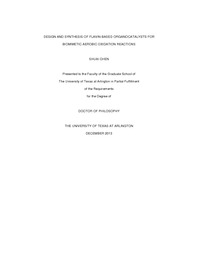
ATTENTION: The works hosted here are being migrated to a new repository that will consolidate resources, improve discoverability, and better show UTA's research impact on the global community. We will update authors as the migration progresses. Please see MavMatrix for more information.
Show simple item record
| dc.contributor.author | Chen, Shuai | en_US |
| dc.date.accessioned | 2014-03-12T23:50:28Z | |
| dc.date.available | 2014-03-12T23:50:28Z | |
| dc.date.issued | 2014-03-12 | |
| dc.date.submitted | January 2013 | en_US |
| dc.identifier.other | DISS-12387 | en_US |
| dc.identifier.uri | http://hdl.handle.net/10106/24109 | |
| dc.description.abstract | Oxidation reactions are among the most costly and least selective transformations in synthetic chemistry. Catalytic methods that utilize O₂ as a terminal oxidant strive to reduce the inefficiency in this large area of synthesis. Recent efforts have been aimed primarily at metal-/organometallic- or enzyme-catalyzed transformations. The goal of the research described in this dissertation was to develop organocatalytic systems based on natural biosynthetic catalysts in order to develop selective metal-free aerobic oxidations that function at room temperature. Prior to our work, riboflavin mimics were previously investigated to understand flavoenzyme function and to perform catalytic oxidations of primarily heteroatom systems. We set out to extend this relatively limited area of organocatalysis to the oxidation of more valuable carbon centers in a mild, chemoselective and stereoselective manner. In Chapter 1, a description of the development and application of biomimetic flavin organocatalysts thus far reported in the literature are summarized. In Chapter 2, the flavin-catalyzed Dakin oxidation is discussed. A range of riboflavin derivatives is used as catalysts to accelerate the transformation of o- or p- hydroxyl benzaldehydes into dihydroxybenzenes using H₂O₂ as the terminal oxidant. An aerobic version of this transformation is developed using the flavin catalysts and NAD(P)H mimics. In Chapter 3, an aerobic asymmetric Weitz-Scheffer epoxidation of enals using flavin and chiral, non-racemic pyrrolidines in a dual catalysis strategy is discussed. High enantioselectivity and diastereoselectivity are observed in the epoxides obtained using this method. A mechanical study is conducted to elucidate the characteristics of the reaction pathway. In Chapter 4, the flavin catalyzed aerobic aromatization of heterocycles is discussed. Riboflavin derivatives are used to convert substituted dihydropyridines and benzothiazolines to pyridines and benzothiazoles with molecular oxygen as terminal oxidant under mild reaction conditions. | en_US |
| dc.description.sponsorship | Foss, Frank | en_US |
| dc.language.iso | en | en_US |
| dc.publisher | Chemistry & Biochemistry | en_US |
| dc.title | Design And Synthesis Of Flavin-based Organocatalysts For Biomimetic Aerobic Oxidation Reactions | en_US |
| dc.type | Ph.D. | en_US |
| dc.contributor.committeeChair | Foss, Frank W. | en_US |
| dc.degree.department | Chemistry & Biochemistry | en_US |
| dc.degree.discipline | Chemistry & Biochemistry | en_US |
| dc.degree.grantor | University of Texas at Arlington | en_US |
| dc.degree.level | doctoral | en_US |
| dc.degree.name | Ph.D. | en_US |
Files in this item
- Name:
- Chen_uta_2502D_12387.pdf
- Size:
- 5.424Mb
- Format:
- PDF
This item appears in the following Collection(s)
Show simple item record


